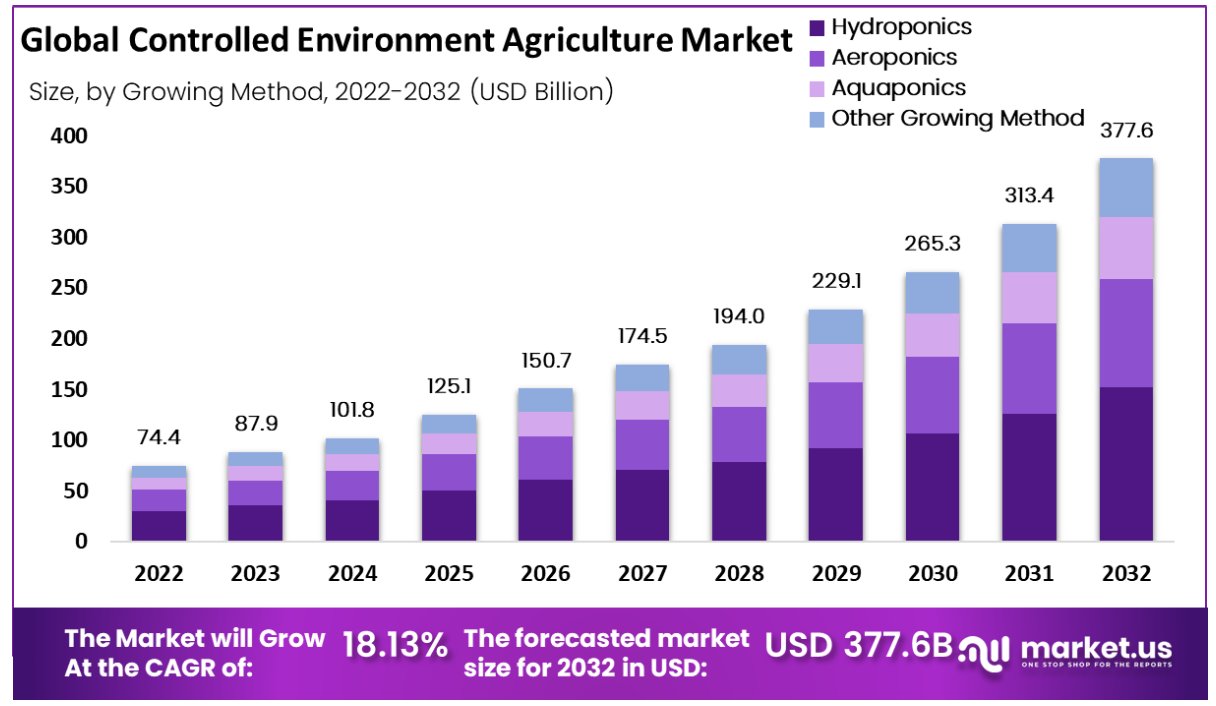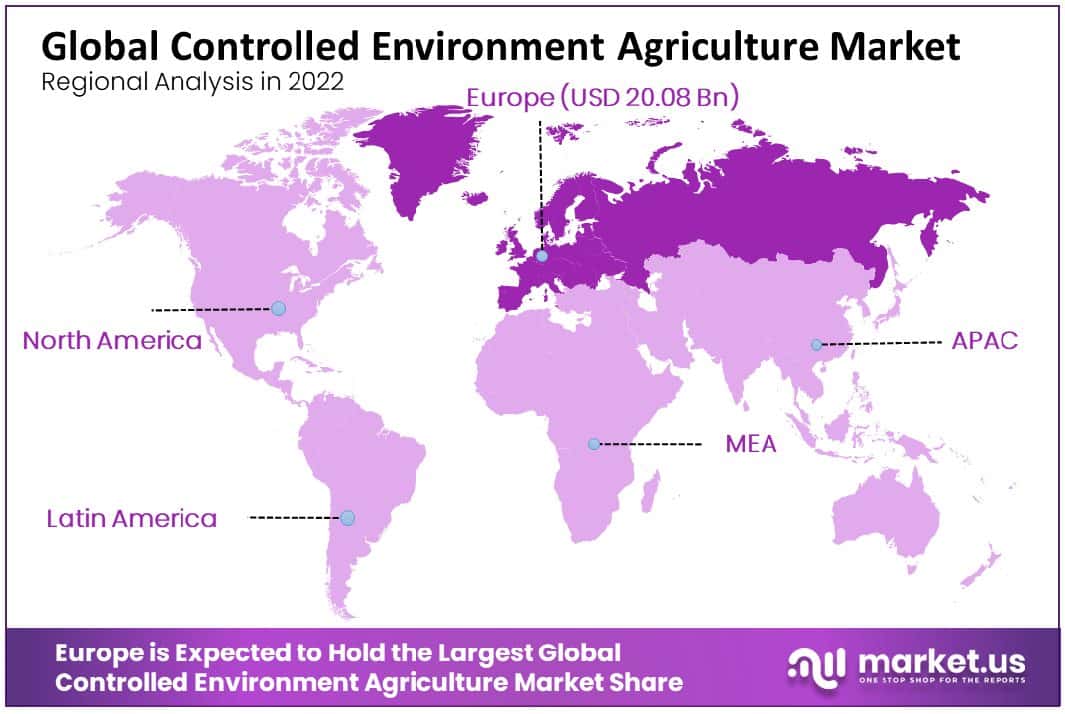Global Controlled Environment Agriculture Market, By Growing Method (Hydroponics, Aeroponics, Aquaponics), By Components(Lighting, Climate Control, Nutrients), By Crop Types(Tomato, Leafy Greens, Strawberries, Cucumber, Pepper, Cannabis), By Region and Companies - Industry Segment Outlook, Market Assessment, Competition Scenario, Trends, and Forecast 2023-2032
- Published date: Sep 2023
- Report ID: 99325
- Number of Pages: 342
- Format:
- keyboard_arrow_up
Quick Navigation
Report Overview
The controlled environment agriculture market size is expected to be worth around USD 377.6 billion by 2032 from USD 74.4 billion in 2022, growing at a CAGR of 18.13% during the forecast period 2022 to 2032.
The technology-based method of controlled environment agriculture (CEA) is used to increase agricultural productivity.
Throughout the crop’s development, CEA aims to safeguard the crop from the weather and provide the perfect conditions for growth, i.e., fast and responsive, inside a covered growing space, such as a greenhouse. The formation of entirely controlled environments for plant growth is known as CEA.
It’s also referred to as vertical farming. This specifies that all those facilities are separated from their surroundings. At certain times, plants require certain resources, such as artificial water and temperature.
Due to the rising demand for fresh and healthful food, particularly in urban areas, as well as the requirement for crop production throughout the year, the worldwide CEA market is anticipated to expand significantly.

Key Takeaways
- Market Growth: In 2022, global controlled environment agriculture market revenues reached USD 74.4 billion; they are anticipated to soar past this figure and exceed it by 2032 with compound annual compounded annual growth rates reaching an astounding 18.13% from 2023-2032.
- Agricultural Environment: Controlled environment agriculture dominates the market due to its growing acceptance in various agricultural applications; however, traditional open-field farming should continue its rise as an option.
- By Growing Method Analysis: Hydroponics is projected to remain the leader of controlled environment agriculture across all other techniques due to consumers’ increased awareness about pesticide-induced plant damage, along with rising consumer expectations of better-tasting fruit and vegetable varieties that offer sustainability.
- By Component Analysis: This segment represents the highest-value component analysis segment within the Controlled Environment Agriculture Market.
- By Crop Type Analysis: Tomato is one of the most beloved categories on the market and represents the greatest revenue worldwide. CEA anticipates it will garner around 45% of revenues through 2022 with further gains anticipated over time.
- Drivers: Demand for sustainable agriculture, climate change challenges, and advances in controlled environment agriculture technology are some key drivers that are fuelling this market.
- Restrictions: High initial setup costs and limited scalability of controlled environment agriculture systems can impede market expansion.
- Opportunities: Breakthroughs in energy-saving technologies, increased investments in research and development, and shifting consumer preferences towards locally grown produce provide market players with substantial growth prospects.
- Trends: Vertical farming, urban agriculture, and year-round crop production have emerged as important market forces in recent years.
- Regional Dominance: By 2022, Europe led in terms of controlled environment agriculture market share with 27%. This was driven by organizations such as SP ZO Co and Fresh Box that offered unique approaches for CEA agriculture such as innovative solutions that combined SPZO Co’s technologies and Fresh Box’s fresh fruit box concept for CEA farming.
- Key Players in the Controlled Environment Agriculture Market: The major companies operating within this niche sector include Aero Farms, Gotham Greens, Plenty, and Lufa Farms among many others.
Market Dynamics
Growing Demand for Fresh & Healthy Food to Help the Market Grow
Demand for healthy, fresh food is rising as consumers become more aware of its advantages and are prepared to pay a premium for it. In spite of climatic circumstances or geographic location, CEA makes it possible to produce fresh and healthful food all year round.
The amount of fertile land accessible for farming is decreasing while the world’s population is increasing. If traditional agriculture is not practical, CEA enables the growing of crops. Consumers are placing a greater emphasis on organic and non-GMO products, and CEA offers a way to produce crops without the use of pesticides and herbicides, which is crucial for the industry.
Restraining Factors
Lack of Knowledge & Lower Adoption Rate
CEA promotes year-round quicker plant development, resulting in higher yields. CEA production is a high-risk, low-margin business similar to all forms of agriculture. A CEA hydroponics plant enterprise demands a significant investment that might reach USD 10 million.
Growers and controlled environment agriculture face significant challenges as a result of the high necessary risk, capital, and operating costs.
By Growing Method Analysis
The Hydroponics Segment Proving to be the Most Lucrative Segment
Hydroponics is anticipated to continue to lead the global controlled environment agriculture market among all growth methods, largely as a result of customers’ growing knowledge of the negative effects that pesticides have on plants and the growing demand for increased tastes and sustainability in diverse fruits & vegetables.
In hydroponics, plants are grown in mineral solutions without soil. It is the most environmentally friendly way to reduce the harmful impact that soil-borne pests and chemicals have on plants. Hydroponics provides a significant return on investment since it requires much less effort, has an inexpensive implementation, and reduces water consumption.
Due to correct nutrition management, plants cultivated hydroponically produce a substantially higher yield than soil-grown plants. It is projected that over the next years, the growing demand for aquaponics will considerably contribute to market growth.
By Components Analysis
The Lighting Segment is the Most Lucrative Segment in the Components Analysis of the Controlled Environment Agriculture Market
The recent several years had lighting components dominate the global market for controlled environment agriculture. This is primarily due to CEA systems’ dependence on artificial lighting, which serves as a replacement for sunshine and delivers the necessary intensity of light for crop development.
In order to satisfy the requirements of the plant and its growth, these artificial lights’ intensity may be easily changed in terms of luminous effectiveness, spectrum, and color temperature. In addition, as LED systems produce less heat than conventional lights, there is a growing demand for them to reduce operating costs and power consumption levels, which is a key factor in the expansion of the lighting component market in general.

By Crop Type Analysis
The Tomato Segment Accounted for the Largest Revenue Share in the Controlled Environment Agriculture Market.
Tomato is the leading segment in this market and accounts for the highest revenue globally; CEA anticipates it will capture 45% of revenue by 2022 and anticipates further growth over the forecast period. Tomatoes have many uses worldwide, from food processing to exports.
Strawberries also account for a substantial share of this segment due to their high demand in Western countries as well as consistent global expansion plans.
Key Market Segments
Based on Growing Method
- Hydroponics
- Aeroponics
- Aquaponics
- Other Growing Method
Based on Components
- Lighting
- Climate Control
- Nutrients
- Other Components
Based on Crop Types
- Tomato
- Leafy Greens
- Strawberries
- Cucumber
- Pepper
- Cannabis
- Other Crop Types
Growth Opportunity
Raising demand for locally-grown produce
Demand for locally farmed food is rising since it is frequently fresher and more environmentally friendly than a product that has been transported great distances. In order to address this expanding need, CEA allows the year-round production of locally farmed food.
Vertical farming
A kind of CEA that includes growing crops in stacked levels, vertical farming enables even increasing crop output densities. This might boost CEA system output and open up new avenues for urban agriculture.
Latest Trends
Leading market participants introduce new products with enhanced capabilities. They perform the essential actions to enhance the items’ general operation. For instance, the vertical hydroponics system was introduced in the UAE in August 2020 by the producer of controlled environment agriculture systems Smart Acres, located in the UAE. The producers may monitor and cultivate crops with the aid of this method while utilizing fewer resources using IoT-based technologies.
Similarly, Controlled Environment Agriculture companies in the agribusiness sector used acquisition as their primary developmental strategy to increase their market share and advance the technology of their products. In August 2021, payAgri Innovations Pvt Ltd, a tech-driven agro and food firm, purchased a 51 percent share from Suumaya Industries Ltd, an Indian textile and agri-commodity company.
Regional Analysis
In 2022, the Controlled Environment Agriculture Market in Europe, which represented 27% of the global market, had the largest market share. This is because leading organizations like SP ZO Co. and Fresh Box provide a large range of cutting-edge approaches for CEA farming.
The largest market growth is expected in North America and Asia-Pacific Owing to their growing populations and urbanization. They will invest in these markets to maintain the correct supply and demand for food products for their regions.

Key Regions and Countries
- North America
- The US
- Canada
- Europe
- Germany
- France
- The UK
- Spain
- Italy
- Russia & CIS
- Rest of Europe
- APAC
- China
- Japan
- South Korea
- India
- ASEAN
- Rest of APAC
- Latin America
- Brazil
- Mexico
- Rest of Latin America
- Middle East & Africa
- GCC
- South Africa
- Rest of MEA
Key Players Analysis
The CEA industry is anticipated to expand over the next few years as a result of rising consumer demand for locally farmed food, technological advancements, and increased worries about the sustainability and security of the food supply.
As a consequence, the industry is anticipated to experience greater competition as new firms enter the market and current players look to expand their operations. Many major firms are present in the fiercely competitive controlled environment agriculture (CEA) sector.
Market Key Players
- Aero Farms
- Gotham Greens
- Plenty
- Lufa Farms
- IDEA Protected Horticulture
- Green Sense Farms
- Metro Farms
- Mirai
- Sky Greens
- Greenland
- Scafil
- Jingpeng
- Metropolis Farms
- Garden Fresh Farms
- Infinite Harvest
- Other Key Players
Recent Developments
- In June 2021- AeroFarms declared their intentions to go public through a merger with Spring Valley Acquisition Corp., an SPAC.
- In February 2021- AeroFarms and Target announced a collaboration to bring fresh produce to select stores throughout the northeastern United States.
- In February 2021 – Plenty announced a collaboration with Driscoll’s to grow strawberries in its vertical farms.
Report Scope
Report Features Description Market Value (2022) USD 74.4 Bn Forecast Revenue (2032) USD 377.6 Bn CAGR (2023-2032) 18.1% Base Year for Estimation 2022 Historic Period 2016-2022 Forecast Period 2023-2032 Report Coverage Revenue Forecast, Market Dynamics, Competitive Landscape, Recent Developments Segments Covered By Growing Method- Hydroponics, Aeroponics, Aquaponics, and Other Growing Methods; By Components- Lighting, Climate Control, Nutrients, and Other Components; By Crop Types- Tomato, Leafy, Greens, Strawberries, Cucumber, Pepper, Cannabis, and Other Crop Types Regional Analysis North America – The US & Canada; Europe – Germany, France, The UK, Spain, Italy, Russia & CIS, Rest of Europe; APAC- China, Japan, South Korea, India, ASEAN & Rest of APAC; Latin America- Brazil, Mexico & Rest of Latin America; Middle East & Africa- GCC, South Africa, &Rest of MEA Competitive Landscape Aero Farms, Gotham Greens, Plenty, Lufa Farms, IDEA Protected Horticulture, Green Sense Farms, Metro Farms, Mirai, Sky Greens, Greenland, Scafil, Jingpeng, Metropolis Farms, Garden Fresh Farms, Infinite Harvest, and Other Key Players Customization Scope Customization for segments, region/country-level will be provided. Moreover, additional customization can be done based on the requirements. Purchase Options We have three licenses to opt for: Single User License, Multi-User License (Up to 5 Users), Corporate Use License (Unlimited User and Printable PDF) Frequently Asked Questions (FAQ)
What is Controlled Environment Agriculture (CEA) Market?Controlled Environment Agriculture refers to the practice of growing crops within a controlled environment, such as greenhouses or indoor vertical farms, where various environmental factors like temperature, humidity, light, and nutrient levels are tightly controlled and monitored. This allows for year-round production, increased crop yield, and reduced reliance on external factors like weather and pests
What are the potential future trends in the Controlled Environment Agriculture market?Potential future trends in CEA include the integration of AI and machine learning for predictive analytics and precise control, the development of more sustainable energy sources for powering indoor farms, and the expansion of CEA into new geographic regions to address local food security and reduce transportation distances.
 Controlled Environment Agriculture MarketPublished date: Sep 2023add_shopping_cartBuy Now get_appDownload Sample
Controlled Environment Agriculture MarketPublished date: Sep 2023add_shopping_cartBuy Now get_appDownload Sample - Aero Farms
- Gotham Greens
- Plenty
- Lufa Farms
- IDEA Protected Horticulture
- Green Sense Farms
- Metro Farms
- Mirai
- Sky Greens
- Greenland
- Scafil
- Jingpeng
- Metropolis Farms
- Garden Fresh Farms
- Infinite Harvest
- Other Key Players
- settingsSettings
Our Clients
| Single User $4,599 $3,499 USD / per unit save 24% | Multi User $5,999 $4,299 USD / per unit save 28% | Corporate User $7,299 $4,999 USD / per unit save 32% | |
|---|---|---|---|
| e-Access | |||
| Report Library Access | |||
| Data Set (Excel) | |||
| Company Profile Library Access | |||
| Interactive Dashboard | |||
| Free Custumization | No | up to 10 hrs work | up to 30 hrs work |
| Accessibility | 1 User | 2-5 User | Unlimited |
| Analyst Support | up to 20 hrs | up to 40 hrs | up to 50 hrs |
| Benefit | Up to 20% off on next purchase | Up to 25% off on next purchase | Up to 30% off on next purchase |
| Buy Now ($ 3,499) | Buy Now ($ 4,299) | Buy Now ($ 4,999) |












